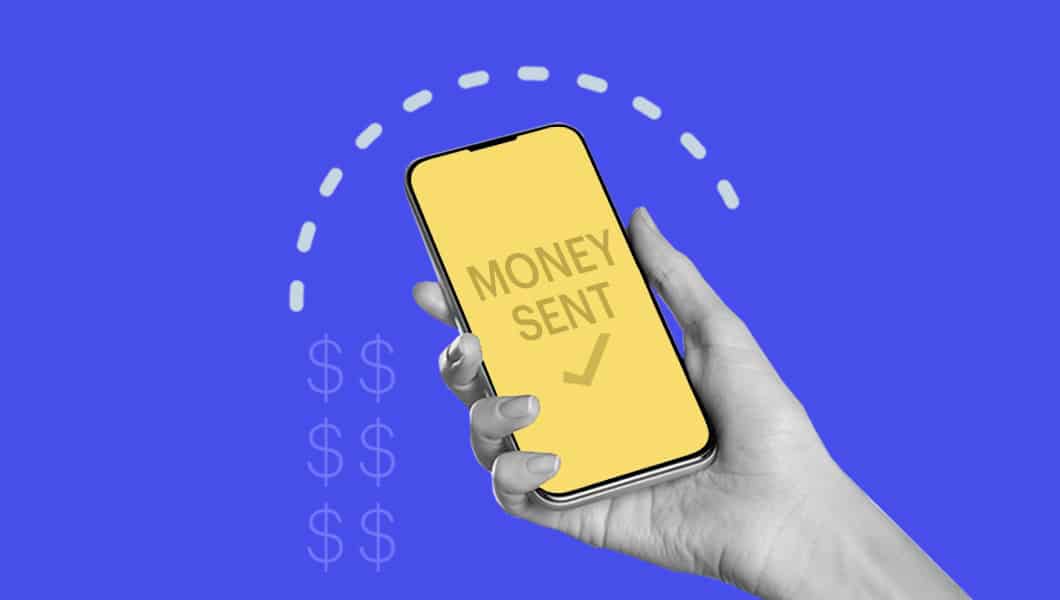What are the best ways to send money if your business needs to make or receive payments? Here’s our guide to your top options.
First, we’ll look at 4 different methods to send money online and offline. Then we’ll review 12 different popular services which use these methods. We’ll cover the pros and cons of each method, including factors such as speed, fees, security and best uses.
4 Ways to Send Money Online
If you’re looking for the best way to send money, your major options include:
- Wire transfers
- Automated clearing house (ACH) payments
- Peer-to-peer (P2P) transactions
- Checks
Let’s look at how each of these methods works and how they compare.
Wire Transfers
A wire transfer is a method of electronic funds transfer (ETF) where money is transmitted directly from one bank account to another. Alternately, cash may be paid at one end of the wire transfer and received at the other end.
Because the transmission of funds from the sender to the recipient is direct, a wire transfer can be the fastest way to send money. Domestic transfers typically are completed within 24 hours, often the same day, while international transfers can take 1 business day to 5 business days.
On the downside, wire transfer fees can be higher than other methods. The speed of wire transfers also can represent a security risk in that if you haven’t verified the receiving party’s identity, the money can be gone before you discover a problem.
ACH Payments
Automated clearing houses are computerized electronic networks that process batches of transactions between participating financial institutions. In the U.S., such payments are overseen by the ACH Network, which is funded by participating financial institutions and governed by rules administered by a nonprofit organization representing network members.
ACH transfers can be used to authorize either credits or debits, in contrast to wire transfers which only can be used to send money. The ACH Network handles credit and debit transactions in batches that are collected from participating financial institutions one or more times a day. Because of this batching procedure, ACH payments may take up to several business days to process, although some transactions may be completed the same day. This means that ACH can be slower than wire transfers.
ACH fees tend to be lower than wire transfer fees. The rules governing ACH transfers can make them the safest way to send money in some cases.
P2P Transactions
P2P transactions use an instant money transfer app to transfer funds between online accounts which are linked to bank or credit card accounts.
When a transaction is initiated, funds may be taken from money stored in the account or drawn from the linked bank or credit card account. The funds then are transferred to the recipient’s account. From there, the funds may be accessed by the recipient through means such as depositing them in a bank account or receiving a physical check.
P2P transactions can be done on a mobile device or another device such as desktop or laptop. Because they’re sent from one digital account to another, the recipient doesn’t have to have an account with the provider. For example, money can be sent to an account linked to an email account, triggering an email notification. The recipient then can choose how to receive the money.
P2P transactions can be as fast as wire transfers and in some cases faster. They also can be the cheapest way to send money online.
P2P transactions can run the same risk as wire transfers of sending money to an unverified recipient. Getting a refund if this happens can be difficult. To reduce this risk, only send P2P funds to verified parties.
P2P accounts are subject to data breaches if your password gets hacked or a third party steals your credentials. Use good security measures to protect yourself when using P2P transactions.
Checks
Checks usually are sent through the mail, but they can be initiated online as well. Some banks allow customers to use online portals or mobile apps to issue personal checks or cashier’s checks.
Upon receiving the check, the recipient may take it to their bank for cashing or depositing or they may use a mobile check deposit through an app. Regular checks may take several days to clear, while funds sent with cashier’s checks may become available immediately. Fees and other details will vary by financial institution.

12 Services for Sending Money
Many services are available for using the methods of sending money covered above. Your local bank may provide some or all of the types of services discussed here. For services not offered by your bank, third-party services are another option.
Here are 12 of the best ways to send money using the methods covered above:
- ACH payments
- Zelle
- Venmo
- PayPal
- Google Pay
- Cash App
- Western Union
- Walmart2Walmart
- Moneygram
- Xoom
- WorldRemit
- OFX
Let’s look at each of these services, their benefits and costs and what they’re best for.
1. ACH Payments
These direct deposit payments frequently are used to pay employees and vendors. ACH transfers also can be used to receive funds. To set up ACH transfers, you will need a business bank account that allows you to send and receive money via ACH. This can be an account with a bank, credit union or payment processor.
ACH payments can take up to several business days. Depending on various factors, they can cost anywhere from free to $10 per transaction, with 29 cents being average. Transfer limits are set by individual financial services providers. If ACH seems like a good option for you, talk to your provider about setting up payments.
2. Zelle
Zelle partners with major banks to facilitate P2P transactions which can be sent using a mobile app or online portal. You can use Zelle to send money to recipients who have an email address or mobile number and a checking or savings account at a U.S. bank. Zelle transactions generally are free. Weekly send limits are set by financial providers, with a $500 limit for users whose bank or credit union doesn’t yet provide Zelle.
Zelle is one of the best money transfer app services available. Your bank may offer Zelle services. Zelle’s site provides a directory of which banks it works with.
3. Venmo
Venmo, owned by PayPal, is a leading rival of Zelle. It lest you send or receive P2P transactions using an online account. Money can be drawn from the account or from a linked bank account, debit card or credit card.
Standard transfers take 1 to 3 business days. Instant transfers are available within 30 minutes from participating banks and debit cards. Sending money from Venmo accounts, bank accounts or debit cards doesn’t cost a fee, while sending funds from credit cards incurs a 3% fee. Unverified accounts have $2,499.99 weekly sending limits, which increase to $24,999.99 for verified accounts.
4. PayPal
Venmo parent PayPal provides money transfer services similar to its subsidiary. Money can be sent from a PayPal account balance, a linked bank account, a debit card, a credit card or a PayPal credit line.
Sending money from PayPal account balances or linked bank accounts is free. Transferring funds via debit card, credit card or PayPal credit line incurs a 2.9% fee. Verified account holders can send up to $60,000, while limits apply to unverified senders.
5. Google Pay
Google Pay, Google’s online payment and digital wallet platform, includes services for sending and receiving money similar to Venmo and PayPal. You can send money using a bank account, debit card or Google Pay balance. The recipient will need a QR code or a name, phone number and email address. Recipients must be in the U.S., India or Singapore. The service can be used through an online portal or through an app available on Android and iOS devices.
Transactions are quickest with Google Pay balances and with debit cards, which can take up to 24 hours, while bank accounts may take 3 to 5 business days. Transfers from Google Pay balances are free, while those involving debit cards cost 1.5% or 31 cents, whichever is higher. Google Pay balances are limited to $25,000, and there are caps on how much you can send over a 7-day rolling period.
6. Cash App
Cash App is a P2P and ACH direct deposit service owned by digital payments provider Square and available in the U.S. and U.K. An online account with a username called a $Cashtag lets you send and receive funds. When you sign up, Cash App provides you with a bank account at partner Lincoln Savings Bank and a debit card. You can link your account to a local bank account or to certain credit or debit cards.
You can send money to any other Cash App user by using their $Cashtag, phone number or email. Sending money from your Cash App account or bank account is free, but sending it from your credit card incurs a 3% fee. Unverified users have a rolling 7-day sending limit of 250 pounds (about $334 as of late December 2021) per 7 consecutive days, raised to 1,500 pounds (slightly more than $2,000) for verified users. Verification is required to send up to 1,000 pounds ($1,335.38) per 7 days internationally.
Cash App transactions are not insured by the Federal Deposit Insurance Commission (FDIC). This means that you aren’t protected from loss on transactions involving mistaken recipients or fraud.
7. Western Union
Western Union, a global leader in the wire transfer market, offers a variety of ways to send money. You can send money online, through an app or by visiting a Western Union location (including those at Walmart locations) in person. Online and app payments can be funded with a bank account, debit card or credit card, while in-person payments require cash. Money may be sent domestically or internationally.
Transfer times vary by method and by location. Some transfers only take minutes, while others may take 1 day to 5 days. Next day transfers are available in some areas, with a $500 limit per day.
Wire transfers funded from banks include fees for both senders and receivers and vary by financial institution, with $20 to $35 being representative of domestic transfers using major banks. Payments funded by credit card may incur a cash advance fee and interest charges from the card issuer. Credit card fees can be avoided with a debit card. Exchange rates apply to international transfers with Western Union and other providers.
8. Walmart2Walmart
Walmart2Walmart is a money transfer service that allows funds to be sent from one Walmart location to another within the U.S. and Puerto Rico. A related service, Walmart2World, supports international transfers in more than 160 countries.
Valid photo identification such as a driver’s license is required to send or receive money. Funds transferred domestically may be available within minutes. Fees start at $4 for transfers of up to $50. Transfers of $51 to $1,000 incur an $8 fee, while those from $1,001 to $2.500 cost a $16 charge.
9. Moneygram
Moneygram, a major competitor of Western Union, provides an online portal and app that can be used to send money domestically or internationally from a credit card, debit card or bank account. Funds can be sent to a debit card, bank account or mobile wallet. Walmart locations can be used to send and receive Moneygram transfers.
Transfers to physical locations take only minutes, but time can vary with location and other factors. Some online transfers to bank accounts may take a few hours or a single day, while others can take several days.
Fees vary with factors such as transfer amount, payment type and pickup location. When sending money with a credit card, advance and interest fees may apply. Exchange rates apply for international transfers. Limits on amounts and frequencies of transfers vary based on factors such as current regulations.
10. Xoom
Xoom is an international money transfer service owned by PayPal. You can send money from a bank account, debit card, credit card or payment methods stored in your PayPal account. Money can be sent to a bank account, sent to a location for pickup or delivered to a physical address.
Some transfers take minutes, while others can take longer, especially when more money is involved. Transfers are free for some bank accounts, while debit and credit transfers can cost more. Exchange rates apply.
Xoom has 3 tiers of limits requiring increasingly different levels of security documentation. At the highest tier, U.S. residents can send up to $100,000 over a 180-day period by providing a driver’s license, passport or Green Card, producing a bank statement or pay stub and answering security questions sent via email.
11. WorldRemit
WorldRemit is an international money transfer service based in London. They allow funds to be sent to over 130 countries online using a mobile phone, app or computer. Funding methods allowed vary by country and include:
- Credit card
- Debit card
- Prepaid card
- Bank account
- Apple Pay
- Klarna
- Poli
- Interac
- IDEAL
- Trustly
- Mobile Money
Money can be transferred to banks, mobile accounts or cash pickup locations. Most transfers take minutes, although times can vary by country and payout method.
Customers in the U.S. can send a maximum of $5,000 per transaction with debit, credit or prepaid cards and $300 with Apple Pay, and up to $9,000 in 24 hours using either method. Security verification requirements vary by amount and by country. In the U.S., a government-issued photo identification card is required.
12. OFX
OFX is an international money transfer service based in Sydney. They allow users to send funds to more than 190 countries in over 50 currencies by using an online account. Money can be sent through electronic bank transfer or through BPAY, an Australian electronic bill pay system. Funds are deposited into the sender’s OFX account through direct deposit or wire transfer and get deposited in the recipient’s bank account.
A minimum transfer of $1,000 is required. OFX doesn’t set a maximum, but banks may set limits. Transfers take an average of 2 to 5 business days.
OFX doesn’t charge fees, so they can be the best way to send money internationally if you’re sending amounts of $1,000 or more from one bank account to another. Exchange rates apply.

Use the Best Money Sending Service for Your Business Needs
Popular methods of sending money online include wire transfers, ACH payments, P2P transactions and checks. Wire transfers are fast but relatively expensive compared to other options. ACH payments are slower but less costly. P2P transactions are fast and inexpensive. Check speed and fees vary by method of check transmission and by provider.
ACH payments can be arranged through your financial institution. Leading P2P providers include Zelle, Venmo, PayPal, Google Pay and Cash App. Major wire transfer providers include Western Union, Walmart2Walmart and Moneygram. Services that support international payments include Xoom, WorldRemit and OFX. Choose the service which best fits your needs.











